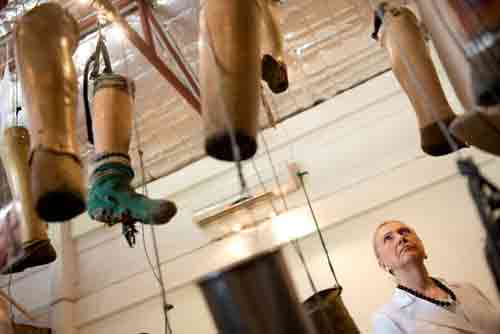
Secretary of State Hillary Clinton looks at prosthetic limbs during a tour
the Cooperative Orthotic Prosthetic Enterprise in Vientiane, Laos.
Photo courtesy Brendan Smialowski, AFP/Getty Images.
July 19, 2012
Earlier this month U.S. Secretary of State Hillary Clinton became the first high level U.S. official to visit Laos since the Vietnam War. Although not touted as such, the visit was an effort to mend fences with Laos, the most heavily bombed nation per capita in history.
While in Laos, Clinton made a visit to the Cooperative Orthotic and Prosthetic Enterprise (COPE) Center to observe medical and rehabilitation services for amputees, many of whom are victims of explosions from bombs left over from the Vietnam War era. The exhibit included dangling cluster bombs and crude wooden artificial legs made by villagers whose limbs had been lost by unexploded ordinance, a legacy of the U.S. secret war.
From 1964 to 1973, the U.S. conducted a secret war in Laos to support the Royal Lao Government against the Pathet Lao. The U.S. flew over Laos from bases in Thailand to bomb the Ho Chi Minh trail in North Vietnam. The B-52s released many of their bombs over eastern Laos. The CIA effort in Laos remains the largest and most expensive paramilitary operation ever conducted by the U.S.
According to the Legacies of War, during this period, the U.S. dropped over 2 million tons of ordinance over Laos in 580,000 bombing missions, the equivalent of one plane load every 8 minutes, 24 hours a day, for 9 years. At least 270 million cluster bombs – a form of air-dropped or ground-launched explosives that releases or ejects smaller sub-munitions – were were dropped as part of this bombing campaign. Approximately 80 million bomblets failed to detonate and thus become land mines.
More than 20,000 people have been killed by the bomblets and more than 98 percent of known cluster bomb victims are civilians with 40 percent of these children who are drawn to the small toy-like metal objects.
In addition, about one-third of Laos is contaminated with unexploded ordinance (UXO) thus prohibiting its use for rice farming.
In 2008, the Diplomatic Conference for the Adoption of a Convention on Cluster Munitions was adopted by 107 countries on May 30, 2008 and signed on 3 December the same year. Seventy-five states are party to the Convention which became binding international law when it entered into force on 1 August 2010. The Convention of Cluster Munitions prohibits the use, production, transfer, and stockpiling of cluster munitions. Shamefully, the U.S. has not signed the treaty although it did not use them in the military operations in Kosovo, Afghanistan, Iraq, or Libya.
Clearly, Clinton’s visit was important and symbolic. Now the U.S. must follow-up her visit by making a commitment to clear U.S.-sourced ordnance in Laos and around the world. Legacies of War urges at least $10 million for UXO for 2013, sustained for the next ten years, and a commitment for “significant, sustained funding for UXO clearance, victim assistance, and mine risk education in Laos. And finally, it is about time for the U.S. to sign the Convention of Cluster Munitions.


 The Hunger Site
The Hunger Site
July 20, 2012 at 10:03 am
on April, 30, 1975 that was the day South vietnam fell into the noth vietnamese’s hand and than they kept moving along the Ho chi minh trail all the way to laos although the US was bombing them in that year.
July 19, 2012 at 2:48 pm
Important story. No one seems to know how many wars the U.S. is fighting now, so it’s easy to forget all the unexploded ordnance the U.S. left behind. I learned about Legacies of War from my friend Nakhone Keodara, a Laotian actor, student, drag queen, gay activist, and survivor of unexploded ordnance, meaning he never put a bare foot down in the wrong patch of dirt or mud puddle as a child in Laos.
I met Nakhone because, he went to Saddleback to protest Obama’s invitation to Rick Warren, and was one of only a few who returned to protest Rick Warren’s presentation of the International Medal of P.E.A.C.E. to Rwandan General Paul Kagame. Having grown up amidst some of the worst scars the Pentagon has left on the planet, he could see that there was more to Rick Warren’s miscreance than Proposition 8.